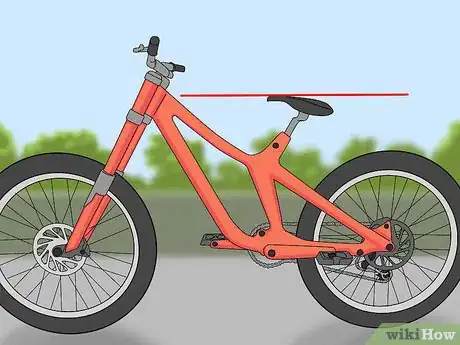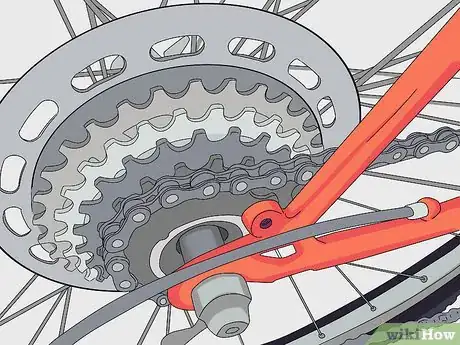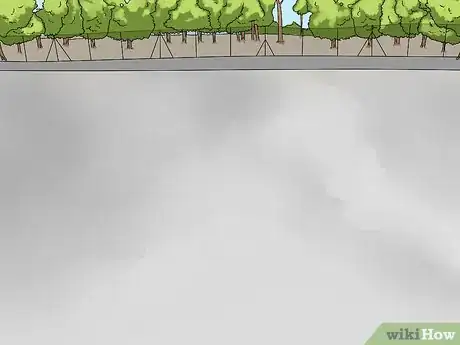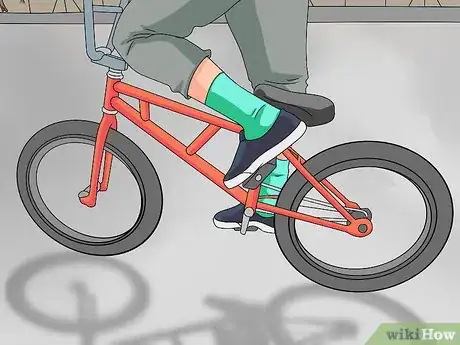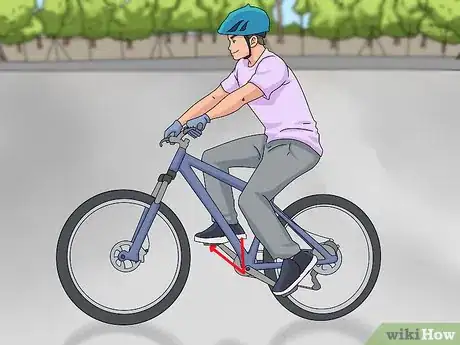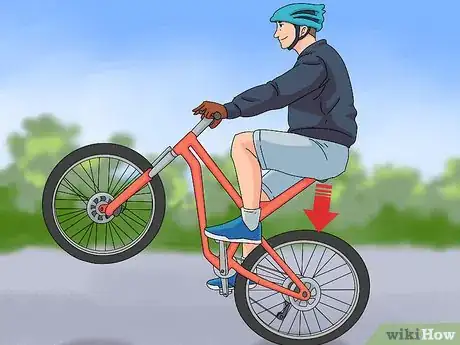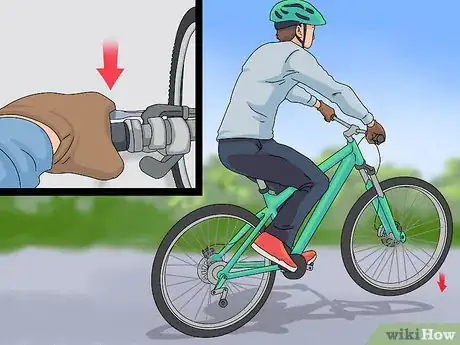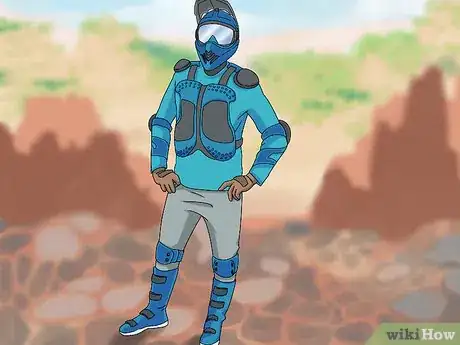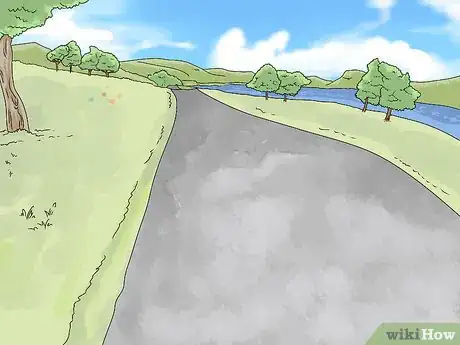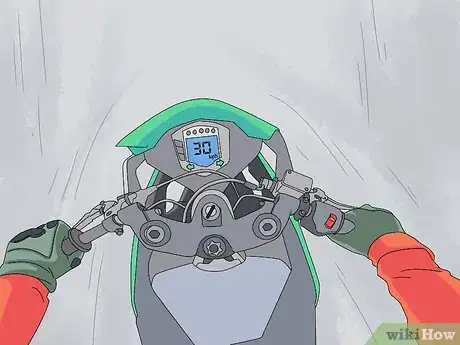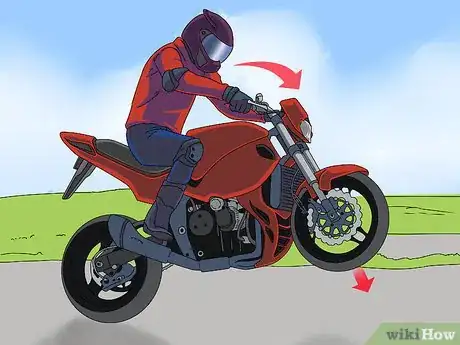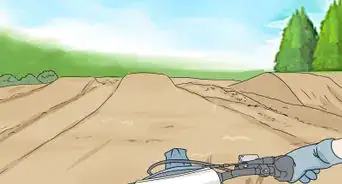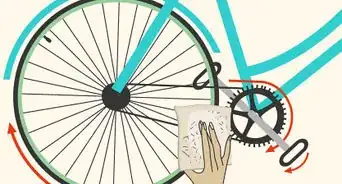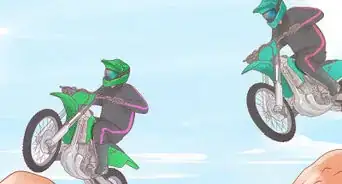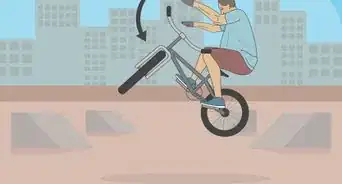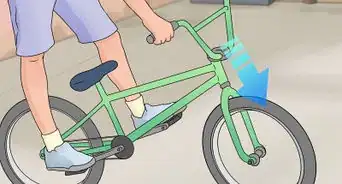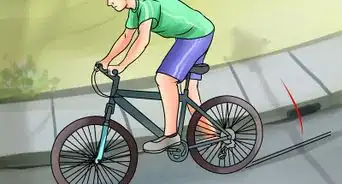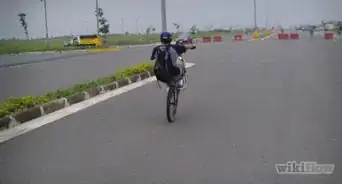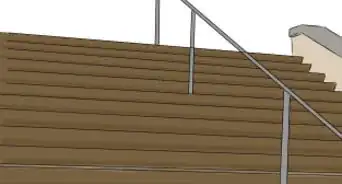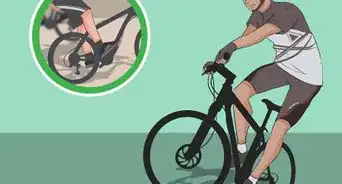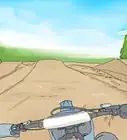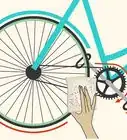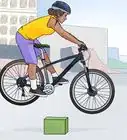This article was co-authored by wikiHow Staff. Our trained team of editors and researchers validate articles for accuracy and comprehensiveness. wikiHow's Content Management Team carefully monitors the work from our editorial staff to ensure that each article is backed by trusted research and meets our high quality standards.
There are 8 references cited in this article, which can be found at the bottom of the page.
This article has been viewed 412,178 times.
Learn more...
Popping a wheelie is a great way to impress your friends or look cool on a bicycle or motorbike. Although it's one of the easiest tricks to learn, if you don't have your balance right it can be a difficult one to master. By accelerating quickly, pulling up on your handlebars and knowing how to position your weight for balance, you can learn to pull off a wheelie on almost anything with two wheels.
Steps
Doing a Wheelie on a Bicycle
-
1Set your seat to a middle position. One of the biggest problems when trying to do a wheelie is overbalancing and falling backward off of your bike. Set your seat so that it is at a medium height or in a middle position, to help adjust your center of balance and make the trick easier.[1]
- As you get more practice at pulling off a wheelie, you can adjust the seat height to whatever you want. Keep in mind that this may change your center of gravity and mean you need to relearn how to balance your bike.
-
2Change your gears to a middle gear. When you're first learning how to do a wheelie, you don't need to be going very fast at all. In fact, it'll be much easier to do your first wheelie if you are going slowly. Set your gears to a middle gear to practice, so that the gear ratio between your front chain rings and your rear cassette divides to be a 1:1 ratio. (standard front gear size on most mountain bikes is 32 - tooth, so set your rear cassette gear to have around 32 teeth on a mountain bike). [2]
- As with the seat height, you can adjust the gear whenever you want. You should be able to do a wheelie no matter what gear you're on. It's much easier to learn on a middle gear, though.
Advertisement -
3Find a large area where you can practice. It'll be much easier to get the right build-up and pull off a wheelie if you can find a large space to practice. Go to a local park or a large field so that you can practice doing wheelies without having to turn around too often.[3]
- Local parks will be great as they are both large and grassy, which will mean you're less likely to get hurt if you fall off your bike. If you don't have a big park nearby, you can also practice on an empty sidewalk, a very quiet road, or anywhere that you can safely ride a bike.
- If you can, try practice your wheelies on a very gentle uphill incline. This will make leaning backward and balancing the wheelie more natural.
-
4Start cycling at a slow to medium pace. Get on your bike and start pedaling to build up a little speed. You should aim for something slightly above walking pace, which will give you just enough speed to pull off a wheelie without going too fast.[4]
- Once you gain more confidence, you can start doing wheelies when traveling at a higher speed. Start slow and gradually get faster as you practice doing a wheelie.
-
5Hold the pedal with your dominant foot at the 2 o'clock position. As you're cycling, work out which is your dominant or stronger foot. Cycle that foot around until it is at the 2 o'clock position on the rotation of your pedals so that you can easily push down on that pedal to quickly accelerate.[5]
- If you don't know which is your dominant foot, try doing a few wheelies leading with each foot and see which way feels more natural.
- Your dominant foot is the foot that you put forward when you feel yourself falling over. While standing straight up, get someone to give you a light shove and see which foot you put forward to stop yourself.
-
6Push down on the pedal sharply and lean backward. Use your dominant foot to push down on the pedal, quickly accelerating the bike and lifting the front wheel slightly. As you do this, hold onto the handlebars and lean backward to pull the front of the bike off the ground. Once you've done this, you've done your first wheelie![6]
- Make sure not to bend your arms more than 10 degrees when you pull back. Doing this is a bad habit, negatively messes with your center of balance, and also does not look nearly as cool.
- Start with small wheelies at first and slowly try and bring the front wheel higher and higher off the ground as you get a better sense of the balance of your bike. It's much safer for you to undershoot the wheelie and let your bike land back on the front wheel than it is to overshoot it and fall backward of the bike.
- If you feel like you're going to fall backward, pull on the rear brake. This will stop the back wheel from moving and set you back down safely on the front wheel.
-
7Shift your weight around slightly to find your point of balance. Once you've lifted the bike off of the ground, start shifting your weight back and forth on the bike to try and find a point of balance. It might take a long time to work out the best position to be in to keep your wheelie going. Keep at it, and eventually, you'll get it right and be able to hold your wheelie for longer.[7]
- If you feel yourself falling backward, tap on the rear brake to lean forward slightly. If you start falling forward, pedal a little faster to gain some more acceleration and tilt backward a little.
- Keep in mind that you'll also need to maintain your balance side to side. Try and keep your weight centered down the middle of the bike to prevent yourself from tipping over. If you feel yourself tilting to one side, slightly shift your weight to the other side or turn the handlebars the other way.
-
8Tap the rear brakes and straighten the front wheel to land the wheelie. Once you start losing balance, you see a shift in terrain coming up, or you just want to stop, hold down the rear breaks to end your wheelie. As you do, make sure that your front wheel is aligned with the rest of the bike. If it's slightly off or facing another way, your front wheel will swerve when it touches the ground and you could fall off.[8]
- Try not to land on your front wheel too harshly. While front suspension will cushion some of the blow, you don't want to put the wheel under any unnecessary stress.
Doing a Wheelie on a Motorbike
-
1Wear full protective gear. Riding a motorbike can be dangerous enough without trying to do tricks on it as well. Always wear full protective gear when riding a motorbike, and especially when practicing tricks.[9]
- Full protective gear includes a helmet, face shield, gloves, jacket, pants, and proper boots. Make sure everything is covered to prevent serious injury if you fall off.
-
2Find a quiet stretch of road to practice. In order to pull off a wheelie, you'll need space to get up to speed, do the wheelie, and land it safely. Try and find a long, flat stretch of road that won't have many cars on it. Take some time to practice riding up and down this road to see how your bike rides and brakes on it.[10]
- Make sure the road doesn't have any big potholes, cracks, or anything that could throw your wheelie off unexpectedly. Find the smoothest, bump-free road that you can when first starting out.
-
3Start riding on first gear at around 25 to 30 kilometres per hour (16 to 19 mph). Start riding your bike and get it into first gear. You don't need to reach a very high speed when first learning how to do a wheelie. Aim for something around 25 kilometres per hour (16 mph), which will let you easily pull off a wheelie without going too quickly.[11]
-
4Snap the throttle back when you reach 6000rpm. Keep riding your motorbike until you get to a comfortable speed and your torque is high enough that the RPM meter is around 6000. In a quick, singular motion, pull the throttle back to quickly accelerate your bike and lift the front wheel off the ground slightly.[12]
- As you do this, lean backward on your bike to lift the wheel up further and get a higher wheelie. This will take a little practice to avoid getting too high, so start small at first.
- Rotate your hand slightly forward and around the throttle before you pull it backwards. This will make pulling back on it sharply much easier, as well as naturally bending your elbow to help you lift up the front of the bike slightly.[13]
-
5Move around on the bike to balance it. Once you get the front wheel off the ground, you'll need to maintain the balance in order to keep your wheelie going. Shift your bodyweight backward to lower the center of gravity, and use the rear brakes and throttle to tilt the bike slightly forward and backward as you need to.[14]
- If at any point you feel like the bike may start “looping” and fall back onto you, hold down the rear brakes immediately. This will stop the wheelie and set you back on the ground.
-
6Lean forward to bring the front wheel back down. The final part of a perfect wheelie is landing it. Lean forward to bring the front wheel toward the ground, staying on the throttle until you have landed. Once both wheels are on the ground again, ease off the throttle to begin slowing down.[15]
- If you need to bring down the front wheel very quickly, shut the throttle off and don't accelerate again until the wheel is just about to touch the ground. Tap the throttle just before the front wheel touches down to soften the landing slightly.
Community Q&A
-
QuestionCan a rookie do this?
 Community AnswerYes, it just takes time to learn. As long as you want to put in the time, you can do it. It is rather time consuming to learn this trick.
Community AnswerYes, it just takes time to learn. As long as you want to put in the time, you can do it. It is rather time consuming to learn this trick. -
QuestionI am young and not very strong. Can I still do a wheelie?
 Community AnswerYes, you can. Just put your bicycle gears on the easiest setting and keep practicing.
Community AnswerYes, you can. Just put your bicycle gears on the easiest setting and keep practicing. -
QuestionHow can I improve my balance?
 Community AnswerTry smaller wheelies at first, and keep practicing. Once you're comfortable with your balance, try longer ones.
Community AnswerTry smaller wheelies at first, and keep practicing. Once you're comfortable with your balance, try longer ones.
Warnings
- Riding a motorbike is very dangerous, especially when you a performing tricks. Always be very careful if you choose to attempt a wheelie, and know that it can be very risky.⧼thumbs_response⧽
- Always wear a helmet when wearing a bicycle. For extra safety, wear knee and elbow pads as well.⧼thumbs_response⧽
- Don't attempt a wheelie on a bicycle with clip-in pedals. If you feel yourself falling over, you won't be able to do anything but fall.⧼thumbs_response⧽
- Check the road rules for motorbikes in your country, as it's illegal to do a wheelie on the road in many countries.⧼thumbs_response⧽
References
- ↑ https://hansrey.com/how-to-do-a-wheelie-on-a-bike/
- ↑ https://youtu.be/TTXncL71jqY?t=34
- ↑ http://www.mtbiking.com.au/skills/how-to-wheelie
- ↑ http://www.mtbiking.com.au/skills/how-to-wheelie
- ↑ https://youtu.be/TTXncL71jqY?t=43
- ↑ https://hansrey.com/how-to-do-a-wheelie-on-a-bike/
- ↑ https://hansrey.com/how-to-do-a-wheelie-on-a-bike/
- ↑ https://youtu.be/TTXncL71jqY?t=103
- ↑ https://www.autoevolution.com/news/how-to-wheelie-on-motorcycle-6833.html
- ↑ https://www.autoevolution.com/news/how-to-wheelie-on-motorcycle-6833.html
- ↑ https://www.autoevolution.com/news/how-to-wheelie-on-motorcycle-6833.html
- ↑ https://www.autoevolution.com/news/how-to-wheelie-on-motorcycle-6833.html
- ↑ https://youtu.be/RF1t4vnMT1U?t=300
- ↑ https://dirtbikeplanet.com/wheelies/
- ↑ https://www.autoevolution.com/news/how-to-wheelie-on-motorcycle-6833.html
About This Article
To do a wheelie, start by setting your bike seat to a medium height and lowering your gears as far as you can, which will make doing a wheelie easier. Then, get on your bike and start pedaling so you're moving at a slow to medium pace. Next, cycle your dominant foot around until the pedal is at the 2 o'clock position and then hold the pedal in place. When you're ready, push down on the pedal with your dominant foot and lean backward to lift the front wheel off the ground. Finally, hold down on the rear brakes to land back on the ground. To learn how to do a wheelie on a motorcycle, scroll down!
